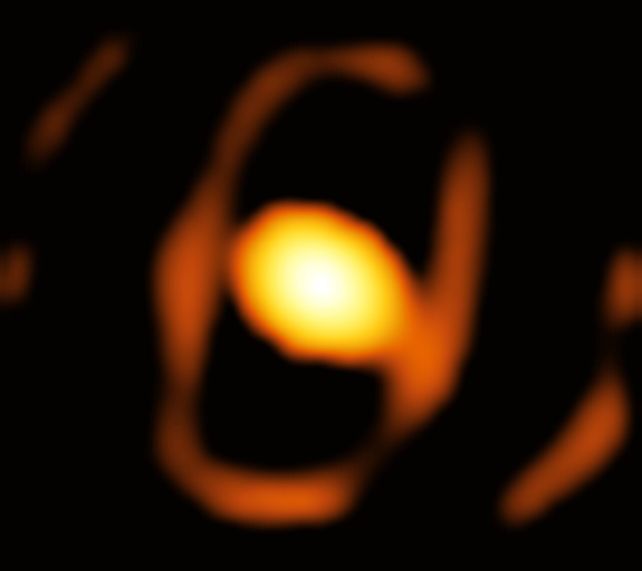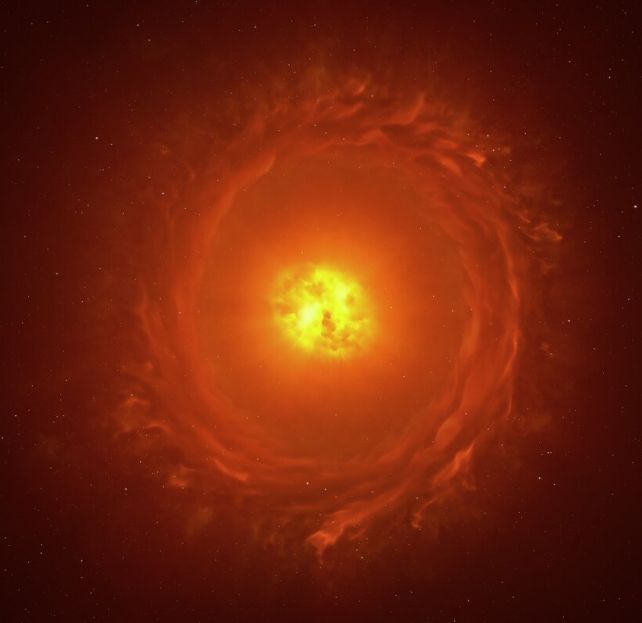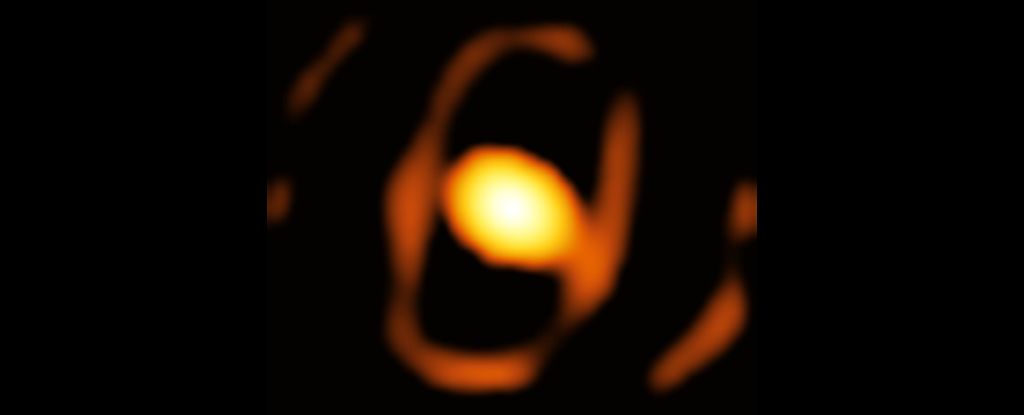Products You May Like
A star more than 160,000 light-years from Earth has just become the epic subject of the first close-up portrait of a star in another galaxy.
It’s called WOH G64, a red supergiant star ensconced in the Large Magellanic Cloud dwarf galaxy orbiting the Milky Way. It’s so large that it has, for some years, been known as “The Monster” or “The Behemoth“, clocking in at nearly 2,000 times the radius of the Sun.
That colossal size is what made it such an ideal target for a portrait using the Very Large Telescope Interferometer at the European Southern Observatory. It’s big enough that we can zoom in and see details that we’ve never seen before.
“We discovered an egg-shaped cocoon closely surrounding the star,” says astrophysicist Keiichi Ohnaka of Andrés Bello National University in Chile. “We are excited because this may be related to the drastic ejection of material from the dying star before a supernova explosion.”

Imaging stars right here within the Milky Way is hard enough. The red giant star Betelgeuse is a perfect example; in spite of being 764 times the radius of the Sun and less than 650 light-years away, our images of the object are so fuzzy that astronomers are still trying to puzzle out why its light fluctuates so dramatically.
WOH G64 is around three times the size of Betelgeuse, but 250 times the distance. So it appears much smaller and dimmer to us than Betelgeuse, which is one of the brightest stars in Earth’s sky. Ohnaka and his colleagues have been studying the Behemoth for years, but had to wait until powerful enough technology emerged to be able to take a detailed portrait.
That technology takes the form of an instrument named GRAVITY, designed to observe very small, very faint objects. Given how far away WOH G64 lies, it certainly fits the bill of small and faint. The researchers took their observations in December of 2020, and then had to undergo the painstaking work of cleaning up, processing, and reconstructing the data to resolve their target.
So, while the image may look fuzzy, the level of detail the researchers were able to obtain is nothing short of incredible.

Observations taken in 2005 and 2007 revealed that WOH G64 is surrounded by dusty material. Since the star is in its red supergiant phase, this is exciting. It’s the end of life for massive stars that started out between about 8 and 35 times the mass of the Sun. As the star runs out of nuclear fuel to fuse in its core, it becomes unstable, burning very hot, and puffing up to a huge size before exploding in a supernova.
The dusty material revealed that WOH G64 is at a very unstable point in its life, experiencing violent mass loss as it grows near to the end.
Now, the new observations have revealed that the star has actually grown dimmer.
“We have found that the star has been experiencing a significant change in the last 10 years, providing us with a rare opportunity to witness a star’s life in real time,” says astronomer Gerd Weigelt of the Max Planck Institute for Radio Astronomy in Germany.
The researchers think that the star’s dimming may be the result of the mass loss it’s been undergoing. The gas and dust it sneezes out blocks some of its light from reaching us, making the star appear dimmer to our telescopes.
frameborder=”0″ allow=”accelerometer; autoplay; clipboard-write; encrypted-media; gyroscope; picture-in-picture; web-share” referrerpolicy=”strict-origin-when-cross-origin” allowfullscreen>
It was the ovoid, egg-like shape of the ejecta bubble that the scientists found surprising. Their modeling based on previous observations suggested the shape should be different. It’s unclear why it has the shape it does, but there could be several explanations.
It could be something to do with the way the material is ejected; the way it moves through the space around the star; or even the presence of an as-yet-unseen binary companion sculpting the outflows in some way scientists have yet to determine.
The Behemoth represents fairly uncharted and exciting territory. The mass loss stage of a red supergiant lasts a few thousand years, which means that the star is really right on the brink. It could tell us things about the way massive stars end their lives we’ve never seen before.
“This star is one of the most extreme of its kind,” says astronomer and director of the UK’s Keele Observatory, Jacco van Loon, “and any drastic change may bring it closer to an explosive end.”
The research has been published in Astronomy & Astrophysics.
